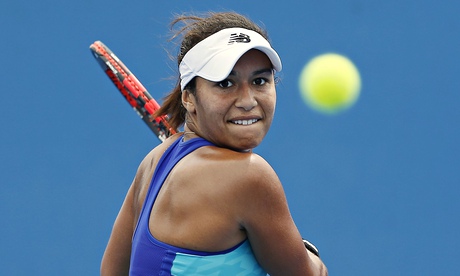
Heather Watson went out of the Australian Open on Tuesday. Big deal, you might say: British tennis player disappoints in the first round. But what makes Watson’s performance surprising is that her poor performance was due to the misalignment of her menstrual cycle and the tour calendar. And she said so: “I think it’s just one of these things that I have, girl things.”
“I was gobsmacked,” says Annabel Croft, the former British tennis No1. “No one ever talks about it. I don’t remember anyone talking about sportswomen like that.” So did Watson’s comments make her want to punch the air?
“It was quite sweet, the way Heather said it,” she says. “You are quite emotional at that time, and a tennis match heightens all that.” As a player, Croft herself never cited her menstrual cycle in a postmatch interview. “It was one of those things that was all hushed up. I remember being on court feeling dizzy, disorientated, tearful, then coming off court, going into the locker room, and finding my period had started – and realising, ah, that’s why I was all over the place.”
As a teenager on the tour, “constantly staying in host families”, wearing “those little white skirts” on court, Croft was “so terrified of leaking” that her mum sent her “this hideous pair [of underwear], like a shower cap. It did the job.” Period-related stress obviously made quite an impression on Croft because she now has her own line of leakproof underwear, called Diary Doll. Very popular with businesswomen and sportswomen, such as “horseriders doing shows with those tight trousers”.
It seems odd, then, that the subject of menstruation in sport comes up so rarely. Perhaps if more women’s sport were televised, periods would come up all the time, a sort of “game of two halves” touchstone in the postmatch interview.
Sporting performance has often been discussed in relation to pregnancy and childbirth, courtesy of Paula Radcliffe, for instance, who also memorably helped put bodily functions on the map when she took a roadside toilet break during the 2005 London Marathon. As Laura Fountain (aka Lazy Girl Running) points out, Radcliffe remains the world record holder for women’s marathon, but the toilet incident “is one of the things people like to bring up. I hope the same doesn’t happen for Heather Watson now.”
Perhaps it would help if sportswomen from all disciplines started talking more openly about the subject, making it commonplace rather than taboo.
“But it’s actually something we talk about all the time,” says Hannah Macleod, the British hockey player. “Being in a team sport, it’s different. There’s 30 females who train full time every day of the week together. It comes up very frequently.”
Indeed, menstrual cycles are monitored, as part of Macleod’s training, by the women’s strength and conditioning coach, Ben Rosenblatt. His inbox must be curious, because each player has to email him “on day one”, says Macleod. The routine began 18 months before London 2012. “It’s something we didn’t want to take any chances on. You get to the final of an Olympics, you want to control every aspect of your performance.”
Research differs as to the impact menstruation has on sportswomen’s performances. In 2011, a study of female rowers tested their heart rates, oxygen consumption, power output, blood lactate levels and other measures of endurance, and found no variation in the results, regardless of where a woman was in her menstrual cycle. But Women in Sport commissioned its own research (in 2010) and found “that in some circumstances, reduction in aerobic capacity and strength were exhibited,” says Ruth Holdaway, the charity’s chief executive. “It is important that sport understands and is sensitive to the potential impacts of the menstrual cycle for female athletes. This is not an issue that should be taboo for sport.”
Macleod says that the British hockey team, inspired in their period-watch by British Triathlon, were offered oral contraceptives to regulate their cycles and reduce the symptoms of premenstrual tension, but only a couple of players accepted. “And they were players who suffered particularly with their symptoms.” Everyone else monitored their cycles and “started to pick up a pattern, so we could manage expectations”.
That sounds like a low-tech solution. “It’s the best solution we’ve got at the moment,” she says. The biggest comfort is the fact that “it’s not something we have to suffer in silence”. So there you go: start talking about it.

